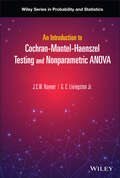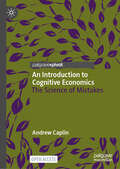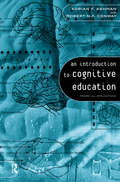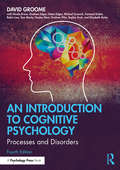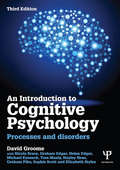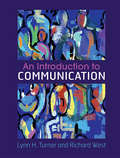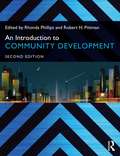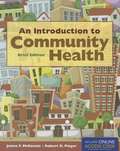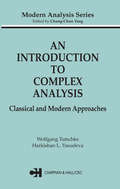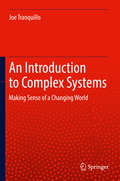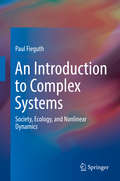- Table View
- List View
An Introduction to Cochran-Mantel-Haenszel Testing and Nonparametric ANOVA (Wiley Series in Probability and Statistics)
by J. C. Rayner G. C. Livingston Jr.An Introduction to Cochran-Mantel-Haenszel Testing and Nonparametric ANOVA Complete reference for applied statisticians and data analysts that uniquely covers the new statistical methodologies that enable deeper data analysis An Introduction to Cochran-Mantel-Haenszel Testing and Nonparametric ANOVA provides readers with powerful new statistical methodologies that enable deeper data analysis. The book offers applied statisticians an introduction to the latest topics in nonparametrics. The worked examples with supporting R code provide analysts the tools they need to apply these methods to their own problems. Co-authored by an internationally recognised expert in the field and an early career researcher with broad skills including data analysis and R programming, the book discusses key topics such as: NP ANOVA methodology Cochran-Mantel-Haenszel (CMH) methodology and design Latin squares and balanced incomplete block designs Parametric ANOVA F tests for continuous data Nonparametric rank tests (the Kruskal-Wallis and Friedman tests) CMH MS tests for the nonparametric analysis of categorical response data Applied statisticians and data analysts, as well as students and professors in data analysis, can use this book to gain a complete understanding of the modern statistical methodologies that are allowing for deeper data analysis.
An Introduction to Cognitive Behaviour Therapy
by David Westbrook Helen Kennerley Joan Kirk`There is much to commend this comprehensive work: it is engaging to read, accessible in style and honestly conveyed. I will certainly be including it as a key text for our university's new CBT module next year. I am reminded once again that contemporary CBT is a therapy for the people; accessible, affordable, resourceful and client empowering' - Therapy Today `[This book] is written in a very readable plain English format that gives the reader an immediate grasp of the concepts… [and] a great insight into the CBT model in a very structured and practical way. I would highly recommend this book to anyone who is curious about CBT' - Eisteach, Irish Association for Counselling and 'This book has been published at the optimum time when references to CBT are ubiquitous, and understanding the principles of this widely publicised intervention is essential. A fine balance of the evidence base, therapeutic interventions and the practicalities of the key components of intervention promotes this text to a higher level of sophistication' - Behavioural and Cognitive Psychotherapy `a worthwhile introduction to CBT and… a thorough overview of the approach that is well supported by research evidence. Written by experience practitioners in an accessible language, this book is recommended for those new to CBT. It is also a useful refresher for the more experienced therapist' - Nursing Standard, 4 star review An Introduction to Cognitive Behaviour Therapy is a beginner's guide to the basic theory, skills, and applications of CBT. Well supported by research evidence, CBT has become one of the most widely practised and most popular therapeutic approaches. For those new to the approach this practical text sets out the core concepts and generic skills of CBT including: " the method of Socratic dialogue " case formulation " the therapeutic relationship " therapeutic strategies - cognitive, behavioural, and physiological. The text then goes on to illustrate how these techniques can be applied to the most common mental health problems - depression, panic and agoraphobia, OCD and health anxiety, social anxiety, and generalized anxiety disorder. Other, less common, disorders are also explored, as are different methods of delivery including work with individuals, groups, couples, and families. This text will be invaluable to all those coming to CBT for the first time whether on training courses or as part of their everyday work. It will also be a useful refresher for those with some experience who want to remind themselves of core skills David Westbrook is Director of the Oxford Cognitive Therapy Centre (OCTC) and a consultant clinical psychologist with Oxfordshire & Buckinghamshire Mental Health Partnership NHS Trust (OBMH). Helen Kennerley is a consultant clinical psychologist with OCTC and OBMH. Joan Kirk was the founding Director of OCTC and is now a consultant clinical psychologist with OCTC and in private practice.
An Introduction to Cognitive Behaviour Therapy: Skills and Applications
by David Westbrook Helen Kennerley Joan KirkThis bestselling guide to the basic theory, skills and applications of cognitive behaviour therapy is fully updated to reflect recent developments in CBT theory. It includes in-depth material on working with diversity, and new case studies and exercises to help you reflect and explore how theory can be used to develop effective practice. The Companion Website features over 40 videos illustrating the CBT skills and strategies discussed in the book, including: · Measuring CBT's effectiveness · Socratic method and applications · Physical techniques and behavioural experiments · Applications of CBT to specific client disorders · Using supervision in CBT.
An Introduction to Cognitive Behaviour Therapy: Skills and Applications
by Helen Kennerley Joan Kirk Mr David WestbrookThis bestselling guide to the basic theory, skills and applications of cognitive behaviour therapy is fully updated to reflect recent developments in CBT theory. It includes in-depth material on working with diversity, and new case studies and exercises to help you reflect and explore how theory can be used to develop effective practice. The Companion Website features over 40 videos illustrating the CBT skills and strategies discussed in the book, including: Measuring CBT’s effectiveness Socratic method and applications Physical techniques and behavioural experiments Applications of CBT to specific client disorders Using supervision in CBT.
An Introduction to Cognitive Economics: The Science of Mistakes
by Andrew CaplinThis book introduces readers to “cognitive economics,” a rapidly emerging interdisciplinary science built on economic, psychological, and data scientific foundations. Throughout the book, economist Andrew Caplin provides new approaches to help scholars collaborate and solve problems that can shape economic outcomes and bridge the gap between theoretical knowledge and the real world. Divided into two parts, the first section brings readers up to speed on economic concepts that underlie decision-making mistakes, such as utility functions, subjective beliefs, and costs of learning. It also explores real-world applications, including improvements in legal decision-making, online privacy protection, and optimizing human-AI collaboration. The book also discusses the future impact of AI on the workforce and emphasizes the need for decision-making skills and financial literacy in navigating this evolving landscape. In the second section of the book, Caplin addresses the barriers to progress within social sciences, advocating for interdisciplinary cooperation and innovative measurement techniques to advance the field. The book invites readers to contribute to the development of cognitive economics. Whether you are a socially-conscious and hard-working citizen, business leader, scholar, or policymaker, this book will help you understand why cognitive economics matters to you and how you can contribute to its takeoff. This book is available open access, which means it is freely available online.
An Introduction to Cognitive Education: Theory and Applications
by Adrian Ashman Robert ConwayThis book provides an accessible introduction to the field of cognitive education. It explains the concepts commonly found in the cognitive psychology and cognitive education literatures, theories and models of human thinking and intelligent behavior, and how these have been applied to psychoeducational assessment, instruction, and the adaption of student behavior. The book includes numerous examples to explain the concepts, theories, and applications, and includes supplementary reading lists and study questions.
An Introduction to Cognitive Linguistics (Learning about Language)
by Friedrich Ungerer Hans-Jorg SchmidLearning About Language is an exciting and ambitious series of introductions to fundamental topics in language, linguistics and related areas. The books are designed for students of linguistics and those who are studying language as part of a wider course. Cognitive Linguistics explores the idea that language reflects our experience of the world. It shows that our ability to use language is closely related to other cognitive abilities such as categorization, perception, memory and attention allocation. Concepts and mental images expressed and evoked by linguistic means are linked by conceptual metaphors and metonymies and merged into more comprehensive cognitive and cultural models, frames or scenarios. It is only against this background that human communication makes sense. After 25 years of intensive research, cognitive-linguistic thinking now holds a firm place both in the wider linguistic and the cognitive-science communities.An Introduction to Cognitive Linguistics carefully explains the central concepts of categorizaÂtion, of prototype and gestalt perception, of basic level and conceptual hierarchies, of figure and ground, and of metaphor and metonymy, for which an innovative description is provided. It also brings together issues such as iconicity, lexical change, grammaticalization and language teaching that have profited considerably from being put on a cognitive basis.The second edition of this popular introduction provides a comprehensive and accessible up-to-date overview of Cognitive Linguistics: Clarifies the basic notions supported by new evidence and examples for their application in language learning Discusses major recent developments in the field: the increasing attention paid to metonymies, Construction Grammar, Conceptual Blending and its role in online-processing. Explores links with neighbouring fields like Relevance Theory Uses many diagrams and illustrations to make the theoretical argument more tangible Includes extended exercises Provides substantial updated suggestions for further reading.
An Introduction to Cognitive Psychology: Processes and Disorders
by David GroomeAn Introduction to Cognitive Psychology: Processes and Disorders provides a comprehensive, yet accessible, overview of the field for undergraduate students. The fourth edition has been thoroughly revised throughout to provide a comprehensive introduction to the core topics of cognition, including memory, perception, thinking, and language. Uniquely, alongside coverage of normal cognitive function, the book also includes chapters on clinical disorders such as agnosia, amnesia, and aphasia, providing a more balanced insight into the nature of cognition and its related disorders. Key features: Completely revised and updated throughout to provide a comprehensive overview of current thinking in the field Accessibly written by experienced textbook authors and academic experts, including Michael Eysenck and Sophie Scott A new chapter on Problem Solving, written by Fernand Gobet, a leading authority in the field Greater coverage of neuropsychological disorders, with additional coverage of brain imaging research Features a wealth of real-world examples throughout to bring research to life Specially designed textbook features, chapter summaries, further reading, and a glossary of key terms An Introduction to Cognitive Psychology will appeal to all students on an undergraduate psychology degree course, as well as to those studying in related clinical professions.
An Introduction to Cognitive Psychology: Processes and disorders
by David GroomeDavid Groome with Nicola Brace, Graham Edgar, Helen Edgar, Michael Eysenck, Tom Manly, Hayley Ness, Graham Pike, Sophie Scott, and Elizabeth Styles. An Introduction to Cognitive Psychology: Processes and Disorders is a comprehensive introductory textbook for undergraduate students. The third edition of this well-established text has been completely revised and updated to cover all the key areas of cognition, including perception, attention, memory, thinking and language. Uniquely, alongside chapters on normal cognitive function, there are chapters on related clinical disorders (agnosia, amnesia, thought disorder and aphasia) which help to provide a thorough insight into the nature of cognition. Key features: Completely revised and updated throughout to provide a comprehensive overview of current thinking in the field Accessibly written and including new authors, including Sophie Scott, Tom Manly, Hayley Ness, and Elizabeth Styles, all established experts in their field A new chapter on Emotion and Cognition, written by Michael Eysenck, the leading authority in the field Greater coverage of neuropsychological disorders, with additional material from the latest brain imaging research that has completely revolutionized neuropsychology Specially designed textbook features, chapter summaries, further reading, and a glossary of key terms A companion website featuring an extensive range of online resources for both teachers and students. Written to cover all levels of ability using helpful figures and illustrations, An Introduction to Cognitive Psychology has sufficient depth to appeal to the most able students while the clear and accessible text, written by experienced teachers, will help students who find the material difficult. It will appeal to any student on an undergraduate psychology degree course, as well as to medical students and those studying in related clinical professions such as nursing.
An Introduction to Cold and Ultracold Chemistry: Atoms, Molecules, Ions and Rydbergs
by Jesús Pérez RíosThis book provides advanced undergraduate and graduate students with an overview of the fundamentals of cold and ultracold chemistry. Beginning with definitions of what cold and ultracold temperatures mean in chemistry, the book then takes the student through the essentials of scattering theory (classical and quantum mechanical), light-matter interaction, reaction dynamics and Rydberg physics. The author aims to show the reader the richness of the topic while motivating students to understand the fundamentals of these intriguing reactions and underlying connecting relationships. Including material which was previously only found in specialized review articles, this book provides students working in the fields of ultracold gases, chemical physics and physical chemistry with the tools they need to immerse themselves in the realm of cold and ultracold chemistry. This book opens up the exciting chemical laws which govern chemistry at low temperatures to the next generation of researchers.
An Introduction to Comets: Post-Rosetta Perspectives (Astronomy and Astrophysics Library)
by Nicolas ThomasWritten by a leading expert on comets, this textbook is divided into seven main elements with a view to allowing advanced students to appreciate the interconnections between the different elements. The author opens with a brief introductory segment on the motivation for studying comets and the overall scope of the book. The first chapter describes fundamental aspects most usually addressed by ground-based observation. The author then looks at the basic physical phenomena in four separate chapters addressing the nucleus, the emitted gas, the emitted dust, and the solar wind interaction. Each chapter introduces the basic physics and chemistry but then new specific measurements by Rosetta instruments at comet Churyumov-Gerasimenko are brought in. A concerted effort has been made to distinguish between established fact and conjecture. Deviations and inconsistencies are brought out and their significance explained. Links to previous observations of comets Tempel 1, Wild 2, Hartley 2, Halley and others are made. The author then closes with three smaller chapters on related objects, the loss of comets, and prospects for future exploration. This textbook includes over 275 graphics and figures – most of which are original. Thorough explanations and derivations are included throughout the chapters. The text is therefore designed to support MSc. students and new PhD students in the field wanting to gain a solid overview of the state-of-the-art.
An Introduction to Communication
by Richard West Lynn H. TurnerPrioritizing brevity and clarity, this textbook introduces the study of communication through examples and applications of communication in a variety of contexts. With a unique focus on diversity and the impact of culture, each chapter opens with a case study that identifies a communication challenge, which the chapter addresses throughout, and concludes with questions that respond to that challenge. A consistent, organized structure with numerous features including fundamental issues, questions for understanding and analysis, theoretical insight (examining a particular relevant theory), and a skill set section, easily guides you through the foundations of the study of communication. Cross-referencing between chapters demonstrates the multidimensional nature of communication and the everyday talk sections demonstrate how each topic relates to technology, the workplace, or health issues. Offering a wealth of diverse examples from students' personal, professional, and online lives, this book teaches skills allowing students from all academic backgrounds to understand communication.
An Introduction to Communication and Artificial Intelligence
by David J. GunkelCommunication and artificial intelligence (AI) are closely related. It is communication – particularly interpersonal conversational interaction – that provides AI with its defining test case and experimental evidence. Likewise, recent developments in AI introduce new challenges and opportunities for communication studies. Technologies such as machine translation of human languages, spoken dialogue systems like Siri, algorithms capable of producing publishable journalistic content, and social robots are all designed to communicate with users in a human-like way. This timely and original textbook provides educators and students with a much-needed resource, connecting the dots between the science of AI and the discipline of communication studies. Clearly outlining the topic's scope, content and future, the text introduces key issues and debates, highlighting the importance and relevance of AI to communication studies. In lively and accessible prose, David Gunkel provides a new generation with the information, knowledge, and skills necessary to working and living in a world where social interaction is no longer restricted to humans. The first work of its kind, An Introduction to Communication and Artificial Intelligence is the go-to textbook for students and scholars getting to grips with this crucial interdisciplinary topic.
An Introduction to Community Development
by Rhonda Phillips Robert PittmanBeginning with the foundations of community development, An Introduction to Community Development offers a comprehensive and practical approach to planning for communities. Road-tested in the authors’ own teaching, and through the training they provide for practicing planners, it enables students to begin making connections between academic study and practical know-how from both private and public sector contexts. An Introduction to Community Development shows how planners can utilize local economic interests and integrate finance and marketing considerations into their strategy. Most importantly, the book is strongly focused on outcomes, encouraging students to ask: what is best practice when it comes to planning for communities, and how do we accurately measure the results of planning practice? This newly revised and updated edition includes: increased coverage of sustainability issues, discussion of localism and its relation to community development, quality of life, community well-being and public health considerations, and content on local food systems. Each chapter provides a range of reading materials for the student, supplemented with text boxes, a chapter outline, keywords, and reference lists, and new skills based exercises at the end of each chapter to help students turn their learning into action, making this the most user-friendly text for community development now available.
An Introduction to Community Health (Brief Edition)
by James F. Mckenzie Robert R. PingerAn Introduction to Community Health Brief Edition is a condensed and fully updated version of the bestselling classic health text. It is ideally suited for students in Health Education, Nursing, and Social Work programs. Like the full-length text, the condensed edition provides comprehensive coverage of epidemiology, adolescent and child health, health and safety in the workplace, environmental health, and minority and elder health. This is the only condensed community health text on the market and is suitable for institutions with shorter academic terms. Key pedagogical features such as chapter objectives, review questions, key terms, and a full glossary can also be found within the brief edition.
An Introduction to Community and Primary Health Care
by Diana Guzys Rhonda Brown Elizabeth Halcomb Dean WhiteheadCommunity nursing is the fastest growing area of nursing practice in Australia. This book offers an engaging introduction to the theory, skills and application of community and primary health care. Based on the 'Social Model of Health', An Introduction to Community and Primary Health Care explores how social and environmental factors impact healthcare in Australian communities. It discusses the principles of health and mental health promotion, the importance of cultural competence and the practice of community needs assessment. The book is divided into three parts - theory, skills and health professionals in practice. This latter section is unique to this book and encourages students to consider how various nursing roles address issues of social justice, equality and access. Readable and highly practical, An Introduction to Community and Primary Health Care equips students with the theory, skills and understanding they will need as community and primary healthcare professionals working across Australia.
An Introduction to Community and Primary Health Care
by Diana Guzys Eileen PetrieCommunity nursing is the fastest growing area of nursing practice in Australia. This book offers an engaging introduction to the theory, skills and application of community and primary health care. Based on the 'Social Model of Health', An Introduction to Community and Primary Health Care in Australia explores how social and environmental factors impact healthcare in Australian communities. It discusses the principles of health and mental health promotion, the importance of cultural competence and the practice of community needs assessment. The book is divided into three parts - theory, skills and health professionals in practice. This section is unique to this book and encourages students to consider how various nursing roles address issues of social justice, equality and access. Readable and highly practical, An Introduction to Community and Primary Health Care in Australia equips students with the theory, skills and understanding they will need as community and primary healthcare professionals working across Australia.
An Introduction to Community and Primary Health Care
by Diana Guzys Elizabeth HalcombAn Introduction to Community and Primary Health Care provides a comprehensive and practical explanation of the fundamentals of the social model of health care approach, preparing learners for professional practice in Australia and Aotearoa New Zealand. The fourth edition has been restructured into four parts covering theory, key skills for practice, working with diverse communities and the professional roles that nurses can enter as they transition to primary care and community health practice. Each chapter has been thoroughly revised to reflect the latest research and includes up-to-date case studies, reflection questions and critical thinking activities to strengthen students' knowledge and analytical skills. Written by an expert team of nurse authors with experience across a broad spectrum of professional roles, An Introduction to Community and Primary Health Care remains an indispensable resource for nursing students and health professionals engaging in community and primary health care.
An Introduction to Compactness Results in Symplectic Field Theory
by Casim AbbasThis book provides an introduction to symplectic field theory, a new and important subject which is currently being developed. The starting point of this theory are compactness results for holomorphic curves established in the last decade. The author presents a systematic introduction providing a lot of background material, much of which is scattered throughout the literature. Since the content grew out of lectures given by the author, the main aim is to provide an entry point into symplectic field theory for non-specialists and for graduate students. Extensions of certain compactness results, which are believed to be true by the specialists but have not yet been published in the literature in detail, top off the scope of this monograph.
An Introduction to Comparative Legal Models of Criminal Justice
by Cliff Roberson Dilip K. DasUpdated to reflect changes in the criminal justice systems in several countries, An Introduction to Comparative Legal Models of Criminal Justice, Second Edition explores and illustrates the idea that a country‘s legal model determines the character of its police, corrections, and legal system. It focuses on how law shapes policing, including how it
An Introduction to Compassion in Healthcare Practice
by Ian McGonagleExplore the concept of compassion as it applies to the field of healthcare and improving patient outcomes An Introduction to Compassion in Healthcare Practice identifies the core components of being compassionate and self-compassionate, so that we may be in a better position to attend to our health and to engage in helping others. The foundation of this book is that if we have an intention to help, we are best served by understanding what ‘helping’ really means. This is addressed by reviewing compassion in a range of contexts and environments, including through an evolutionary science perspective. In this view, we are ‘programmed’ to be compassionate—but social forces may throw challenges or obstacles in our way. Also covered in this text are the challenges associated with being compassionate to the self, as well as care encounters with individuals in a clinical context and working in a clinical team. Some of the ideas explored in An Introduction to Compassion in Healthcare Practice include: Artificial intelligence (AI) and compassion, covering ethical theories for AI alongside considerations surrounding consent and the role of touch The role of mindfulness in self-compassion, the challenges and benefits of self-compassion, perfectionism, our “inner critic”, and shame Complex Adaptive Systems (CAS) in teamwork, lessons in developing compassionate teams, and the theory of Values-Based Practice Components of compassion-focused leadership and supervision, and the development of self-efficacy and competence Providing a core conceptual framework for compassion in healthcare with guidance on how to explore various topics in greater depth, An Introduction to Compassion in Healthcare Practice is an essential reference for undergraduate nurses, midwives, allied health professionals, medical practitioners, and students in related programs of study.
An Introduction to Complex Analysis and the Laplace Transform (Textbooks in Mathematics)
by Vladimir EidermanThe aim of this comparatively short textbook is a sufficiently full exposition of the fundamentals of the theory of functions of a complex variable to prepare the student for various applications. Several important applications in physics and engineering are considered in the book.This thorough presentation includes all theorems (with a few exceptions) presented with proofs. No previous exposure to complex numbers is assumed. The textbook can be used in one-semester or two-semester courses.In one respect this book is larger than usual, namely in the number of detailed solutions of typical problems. This, together with various problems, makes the book useful both for self- study and for the instructor as well.A specific point of the book is the inclusion of the Laplace transform. These two topics are closely related. Concepts in complex analysis are needed to formulate and prove basic theorems in Laplace transforms, such as the inverse Laplace transform formula. Methods of complex analysis provide solutions for problems involving Laplace transforms.Complex numbers lend clarity and completion to some areas of classical analysis. These numbers found important applications not only in the mathematical theory, but in the mathematical descriptions of processes in physics and engineering.
An Introduction to Complex Analysis: Classical and Modern Approaches (Modern Analysis Series)
by Wolfgang Tutschke Harkrishan L. VasudevaLike real analysis, complex analysis has generated methods indispensable to mathematics and its applications. Exploring the interactions between these two branches, this book uses the results of real analysis to lay the foundations of complex analysis and presents a unified structure of mathematical analysis as a whole.To set the groundwork
An Introduction to Complex Systems: Making Sense of a Changing World
by Joe TranquilloThis book explores the interdisciplinary field of complex systems theory. By the end of the book, readers will be able to understand terminology that is used in complex systems and how they are related to one another; see the patterns of complex systems in practical examples; map current topics, in a variety of fields, to complexity theory; and be able to read more advanced literature in the field. The book begins with basic systems concepts and moves on to how these simple rules can lead to complex behavior. The author then introduces non-linear systems, followed by pattern formation, and networks and information flow in systems. Later chapters cover the thermodynamics of complex systems, dynamical patterns that arise in networks, and how game theory can serve as a framework for decision making. The text is interspersed with both philosophical and quantitative arguments, and each chapter ends with questions and prompts that help readers make more connections.
An Introduction to Complex Systems: Society, Ecology, and Nonlinear Dynamics
by Paul FieguthThis undergraduate text explores a variety of large-scale phenomena - global warming, ice ages, water, poverty - and uses these case studies as a motivation to explore nonlinear dynamics, power-law statistics, and complex systems. Although the detailed mathematical descriptions of these topics can be challenging, the consequences of a system being nonlinear, power-law, or complex are in fact quite accessible. This book blends a tutorial approach to the mathematical aspects of complex systems together with a complementary narrative on the global/ecological/societal implications of such systems. Nearly all engineering undergraduate courses focus on mathematics and systems which are small scale, linear, and Gaussian. Unfortunately there is not a single large-scale ecological or social phenomenon that is scalar, linear, and Gaussian. This book offers students insights to better understand the large-scale problems facing the world and to realize that these cannot be solved by a single, narrow academic field or perspective. Instead, the book seeks to emphasize understanding, concepts, and ideas, in a way that is mathematically rigorous, so that the concepts do not feel vague, but not so technical that the mathematics get in the way. The book is intended for undergraduate students in a technical domain such as engineering, computer science, physics, mathematics, and environmental studies.
